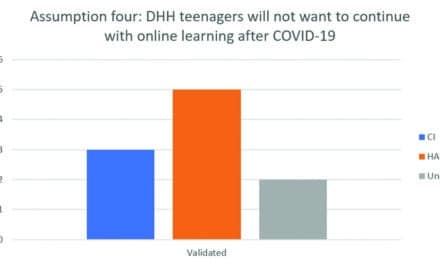By Geoffrey Waring, Writer, USC
Dr Raymond Goldsworthy, head of the Bionic Ear Lab in the USC Caruso Department of Otolaryngology-Head and Neck Surgery, understands the importance of music listening. He lost his hearing at the age of thirteen, just as he was beginning to learn the drums. Like every teenager, he was just beginning his journey into the seemingly limitless world of music, when a bout with spinal meningitis and the ensuing treatment damaged his hearing. An article detailing his story appears on the Keck School of Medicine website.
“There is never a good time to lose your hearing, but what was particularly challenging for me at that age was that my friends were discovering new music,” Goldsworthy remembers. “It hurt that I could not turn to music for comfort during that time.”
He received a cochlear implant, then a relatively new technology that has since become a life-changing device for hundreds of thousands of hard-of-hearing people. Cochlear implants are sound processors that sit behind the ear, catching sound and transmitting it via electrodes that stimulate the auditory nerve. The result is an approximation of hearing that, while perhaps less precise than an average person’s, can help restore a remarkable degree of ability when hearing loss has progressed to the point that a hearing aid is no longer useful.
And, as Goldsworthy and his researchers at the Bionic Ear Lab have shown, technology and music listening can always be improved.
As a music enthusiast and a musician, Goldsworthy and his team have spent years researching ways to improve the experience of music for cochlear implant users. Their most recent paper (available here), which was co-authored by graduate student Andres Camarena and medical student Grace Manchala, set out to examine exactly how cochlear implant users perceive harmonies.
They did this by setting up an at-home test via a web app, which played two notes together at a time and asked participants to rate what they heard on a scale of pleasantness. The study not only compared cochlear implant users to normal-hearing listeners, but also captured the participant’s musical sophistication — how much they knew about music, how much they’d studied music, their own musicianship.
Previous studies on this topic had concluded that cochlear implant users were largely incapable of distinguishing pleasing or discordant harmonies. This surprised Goldsworthy, who runs a weekly music appreciation meeting for cochlear implant users (you can read more about the Cochlear Implant Music Hour here), and who had seen first-hand how cochlear implant users were capable of very sophisticated appreciation of melodies and harmonies.
“Science often follows careful observation. Knowing many cochlear implant users who are lifelong musicians allowed my lab to better understand the importance of experience for relearning how to hear subtle differences in harmony,” Goldsworthy said. “The Cochlear Implant Music Hour showed us that many cochlear implant users have excellent access to harmony.”
The findings of the study were astonishing. While average cochlear implant users indeed had a much rougher perception of pitch changes than the average listener’s (the former were able to hear pitch changes of about 10%, compared with an average listener’s 1%), the highest-performing cochlear implant users were able to distinguish pitch differentiation at about the same rate as average users. More surprising still, the thing that seemed to differentiate ability to hear differences in pitches most among cochlear implant users, aside from the technological issue of being able to hear small modulations in the stimulation that allows the user to hear, was musicianship and musical sophistication.
“The science did naturally follow the observations drawn from the music hour,” Goldsworthy observed. “We were able to design a listening experiment to carefully characterize harmony perception and to connect that to musicianship.”
This result confirmed what Goldsworthy had long known from personal experience: that cochlear implant technology can be improved both through technological progress and through the brain’s astonishing ability to learn new skills. Indeed, in his own journey to music appreciation with a cochlear implant, Goldsworthy discovered that, as technology behind cochlear implants improved, so did his ability to appreciate music — but that, in tandem, just as important was his own evolving appreciation of music as a listener and musician.
“Music appreciation for cochlear implant users is a beautiful meeting of mind and technology,” Goldsworthy said. “Cochlear implant users can improve their music appreciation by bravely diving into music, but there is also plenty of room to improve how sound is encoded into stimulation to allow recipients to dive even deeper.”
The results of the study provide quite a bit of hope for cochlear implant users longing to enjoy a high-level appreciation of music: they show that a similar level of appreciation to normal-hearing listeners is possible with improving technology and learned musical sophistication. Future research in the Bionic Ear Lab will continue to focus on how to move average cochlear implant users’ music listening experience toward the level that the highest-performing cochlear implant users are currently experiencing — in other words, a similar appreciation of music to that of normal-hearing listeners.
“Our research aims to carefully characterize music perception for cochlear implant users. The more precisely we characterize music perception, the better we can improve sound processing for further improvements,” Goldsworthy said. “I am excited to work with a vibrant team to broadly improve music appreciation for cochlear implant users.”
The Bionic Ear Lab is looking for more people to get involved with hearing research at USC, both cochlear implant users and people with normal hearing for comparison. Reach them at: [email protected].
Original Paper: Camarena A, Manchala G, Papadopoulos J, O’Connell SR, Goldsworthy RL. Pleasantness ratings of musical dyads in cochlear implant users. Brain Sciences. 2022;12(1):33.
Source: Keck School of Medicine, Brain Sciences
Image: Kristin Brokaw






